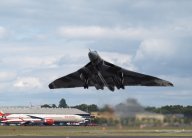Avro Vulcan
Unfortunately, Vulcan XH558 will now be grounded forever unless further funding of £1million is identified by early 2009. This funding will allow the project to pay its monthly expenses, clear debt and provide a stable financial footing for the future. -- Vulcan to the Sky Trust
 Post-WWII, the policy of the RAF of massed bombing raids changed to one of a single aircraft delivering a nuclear bomb. For this a new generation of aircraft was required known as the V bombers. This was the policy during the 1950s and 1960s. Until these new bombers came into service, in the immediate aftermath of World War Two, the RAF still relied upon massed bomber raids, the Avro Lancaster replaced by the Avro Lincoln.
Post-WWII, the policy of the RAF of massed bombing raids changed to one of a single aircraft delivering a nuclear bomb. For this a new generation of aircraft was required known as the V bombers. This was the policy during the 1950s and 1960s. Until these new bombers came into service, in the immediate aftermath of World War Two, the RAF still relied upon massed bomber raids, the Avro Lancaster replaced by the Avro Lincoln.
V bombers, Avro Vulcan (first flew 1952), Vickers Valiant (first flew 1951) and the Handley Page Victor (first flew 1952), formed the UK's strategic nuclear strike force. By June 1964, 50 Valiants, 39 Victors and 70 Vulcans were in service.
The Avro Vulcan, a subsonic delta wing bomber, was designed by Roy Chadwick in 1947, chief designer and head of the design team at A V Roe. Roy Chadwick also designed the Avro Lancaster and Avro Lincoln.
The Vulcan first entered service in 1956. The first Vulcan squadron, Squadron 83, was formed at RAF Waddington in Lincolnshire in May 1957. Later 44 Squadron and 50 Squadron at RAF Waddington were to acquire Vulcans, first the B1 then the B2 variant.
Vulcans were on a moment's standby to deliver nuclear bombs deep into the heart of the Soviet Union. During the Cuban Missile Crisis, they were on heightened alert.
 The Vulcan only saw active service when its retirement was postponed and they were used in the Falklands War in 1982.
The Vulcan only saw active service when its retirement was postponed and they were used in the Falklands War in 1982.
The UK's strategic nuclear strike force had a distinctive advantage over that of the US in that they could hit targets deep inside the Soviet Union hours earlier. Effective anti-aircraft missiles made the airborne delivery of nuclear bombs obsolete. The UK's strategic nuclear strike capability passed to the Royal Navy first with Polaris, then Trident. Nuclear missiles carried on board nuclear submarines.
134 Vulcans were built, more than a dozen Vulcans still survive. Only one, XH558, is airworthy. There are attempts to make XL426 at Southend Airport airworthy. XM607 is on display at RAF Waddington.
XH558 flew in 2008 at the Waddington International Airshow, at the Farnborough International Airshow, then took part in a commemorative flight for the first flight by Samuel Cody at Farnborough. XH558 was grounded at Farnborough for over three weeks. It managed to limp home and has not flown since. Unless guaranteed secure funding can be obtained, it is unlikely to fly again. XH558 saw service at RAF Waddington. It was the last Vulcan in service. From 1986 to 1992 it was the RAF's display aircraft.
With the high cost of repairs and the global economic crisis biting hard, the Vulcan was not expected to fly again, nevertheless the impossible was achieved and it took to the skies again for the RAF Cosford airshow. An astonishing half a million pounds was raised in five days after The Mail on Sunday launched an appeal on behalf of the Vulcan to the Sky Trust. In total about a million pounds was raised. Spectators at RAF Brize Norton got a sneak preview of Vulcan XH558 as it underwent trials. In addition to repairs, XH558 underwent a full service. The Vulcan is scheduled to fly again at the RAF Waddington International Air Show (4-5 July 2009).
XH558 may form part of the fly past for the opening ceremony of the 2012 Olympics in London!
Lincolnshire ~
50 Squadron ~
RAF Waddington
(c)
Keith Parkins 2009 --
June 2009 rev 1
 Post-WWII, the policy of the RAF of massed bombing raids changed to one of a single aircraft delivering a nuclear bomb. For this a new generation of aircraft was required known as the V bombers. This was the policy during the 1950s and 1960s. Until these new bombers came into service, in the immediate aftermath of World War Two, the RAF still relied upon massed bomber raids, the Avro Lancaster replaced by the Avro Lincoln.
Post-WWII, the policy of the RAF of massed bombing raids changed to one of a single aircraft delivering a nuclear bomb. For this a new generation of aircraft was required known as the V bombers. This was the policy during the 1950s and 1960s. Until these new bombers came into service, in the immediate aftermath of World War Two, the RAF still relied upon massed bomber raids, the Avro Lancaster replaced by the Avro Lincoln.
